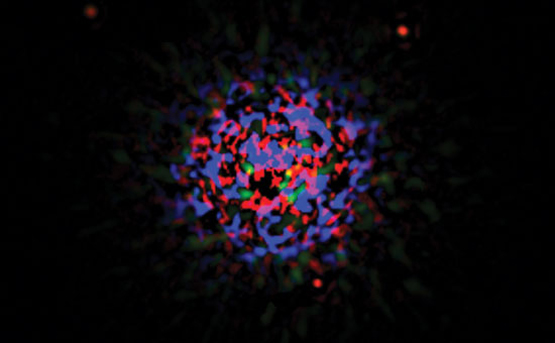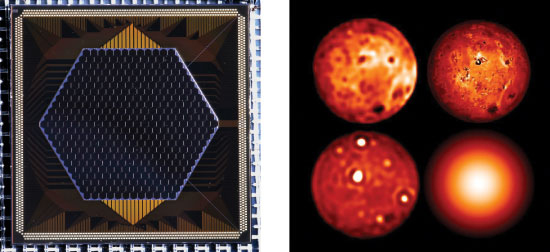Seeing into Space
Two research projects refine and redefine our understanding of the galaxy

How do you see the invisible?
Four centuries years ago, Galileo Galilei used a little help. Improving telescope designs by Hans Lipperhey, he turned his telescope to the sky and was able to observe the moon, discovered four satellites of Jupiter, and resolved nebular patches into stars.
 Since Galileo’s time, telescopes have focused on faint blobs and splotches in space, but Thomas Bifano, director of the Boston University Photonics Center, has helped fine-tune those discoveries, making them a little clearer. Bifano’s research with silicon microelectromechanical (MEMS) deformable mirrors allows for high-resolution, high-contrast astronomical imagery, using adaptive optics. A semiconductor fabrication process created in Bifano’s foundry made the technology accessible. Instead of launching a telescope into space to avoid this planet’s messy, blurry atmosphere, astronomers can use adaptive optics. The precisely controlled warping of the deformable mirror straightens out distorted light.
Since Galileo’s time, telescopes have focused on faint blobs and splotches in space, but Thomas Bifano, director of the Boston University Photonics Center, has helped fine-tune those discoveries, making them a little clearer. Bifano’s research with silicon microelectromechanical (MEMS) deformable mirrors allows for high-resolution, high-contrast astronomical imagery, using adaptive optics. A semiconductor fabrication process created in Bifano’s foundry made the technology accessible. Instead of launching a telescope into space to avoid this planet’s messy, blurry atmosphere, astronomers can use adaptive optics. The precisely controlled warping of the deformable mirror straightens out distorted light.
Astronomers have been able to find massive black holes at the merger of two distant galaxies with adaptive optics, and in our own solar system, deformable mirrors have shown the rings of Uranus and allowed Jeffrey Baumgardner (GRS’77) and Jody Wilson, senior research associates at the Center for Space Physics, and College of Arts & Sciences Astronomy Professor Michael Mendillo (GRS’68,’71) to see the sodium tail of Mercury.
“One big goal for astronomy is to not only peer deeper into the universe, but do so more precisely,” says Bifano, a College of Engineering professor and a member of the University’s Center for Space Physics and the Fraunhofer Center for Manufacturing Innovation. With Paul Bierden (ENG’92,’94), Bifano cofounded Boston Micromachines Corp., a business leader in the production of deformable mirrors for astronomy, defense, and bioimaging. “If I can see an Earth-like planet around a bright star,” Bifano says, “then I can measure the light coming back from that and say, ‘Oh, there’s carbon dioxide, or oxygen, there. There might be people living there.’”
Last year, scientists made the first direct observation of exoplanets, planets circling other stars, including the bright star Fomalhaut, 25 light-years from Earth, and a star called HR 8799, 128 light-years from Earth.
“We had found exoplanets before, but we’d found them by watching a star ‘wobble’ as a planet orbits the star,” says Bifano. The exoplanet’s gravitational tug creates that wobble. “But the star’s so bright and the planet’s so dim, you can’t see the planet. It would be like trying to see someone holding a match behind someone holding a floodlight. The way you see the planet is to make the telescope’s optics perfect, and the deformable mirror helps with that.”
A culmination for Bifano was winning the Bepi Colombo Prize this past February for his career-long research. He received the prize during a ceremony at the University of Padua in Italy — where Galileo chaired the mathematics department from 1592 to 1610.

Another look
The work of Nathan Schwadron, a CAS associate professor of astronomy, with the Interstellar Boundary Explorer (IBEX) is expanding the realm of astronomical discovery a little closer to home — mapping the edges of our solar system.
Launched into space in October 2008 on the back of a Pegasus-XL rocket, the IBEX satellite looks for the solar system’s boundary, where the solar wind and interstellar medium collide. The mission is led by the Southwest Research Institute, Los Alamos National Laboratory, and the Lockheed Martin Advanced Technology Center.

Schwadron invokes Dr. Seuss when he describes IBEX. “I can liken it to Horton Hears a Who,” he says. “You have little Whos sitting in their part of the universe, and they know about the sun and that there’s a region outside them. But all they know is kind of the most distant properties; they’ve forgotten there’s this intermediate environment. Horton is also there, and they don’t realize it.
“With IBEX, there’s a discovery of how we fit in with our own cosmic environment.”
Schwadron’s CAS lab collects and processes information sent back about the interstellar medium, built up from material released from our galaxy by stellar winds, novae, and supernovae. IBEX images show the boundary where our sun’s solar wind, at the heliosphere, meets the local interstellar medium, called the termination shock.
“For years we’ve built astronomy on photons,” says Schwadron. “But we’re not looking at photons; we’re looking at energetic neutral atoms that are born on the edge of our solar system.”
In space, charged particles interact with electromagnetic fields. But when a particle is neutral and has no charge, it has no way to interact with those fields and it moves in straight lines. The IBEX team uses these neutral atoms to measure energetic particles in the medium around the solar system to image plasmas, or ionized gases, the way an ordinary camera records light, to see where the boundary begins.
 “People have been sending probes out to image individual sections of the cocoon around Earth, the Earth’s magnetosphere,” says Schwadron. “Now with these neutral atoms, we can actually image the whole thing. For the first time, images showed us that these are global boundaries surrounding us, these are global dynamics.”
“People have been sending probes out to image individual sections of the cocoon around Earth, the Earth’s magnetosphere,” says Schwadron. “Now with these neutral atoms, we can actually image the whole thing. For the first time, images showed us that these are global boundaries surrounding us, these are global dynamics.”
While Schwadron was developing the IBEX proposal in 2004, NASA’s Voyager I, a probe launched in 1977, hit the termination shock of the heliosphere, entering the heliosheath, the region of the heliosphere beyond the termination shock, where the solar wind slows down. Voyager II hit the termination shock in 2007. Measurements sent back recorded only two specific locations and time, two pinpricks in the fabric of the interstellar boundary.
“Voyager I made the first measurements of the termination shock, which was amazing, because it was the actual discovery of it,” he says. “But at the end of the day, it was just the measurement of those two points. With IBEX, we get to see the whole thing.”
Schwadron says that the IBEX maps turned up new findings, revealed last week, forcing scientists to reconsider their basic assumptions about how the heliosphere is formed. “The most striking feature is a ribbon that appears to be controlled by the magnetic field of our galaxy,” he says.
The ribbon’s existence “suggests that the galactic magnetic fields are much stronger and exert far greater stresses on the heliosphere than we previously believed,” says Geoffrey Crew, a research scientist at MIT and the software design lead for IBEX.
“IBEX is pushing the frontier of space science, of what we can detect locally, into the realm of what we know about the galaxy,” says Schwadron. “IBEX is about bringing the two worlds of astronomy and space science together.
“Astronomy is all about seeing what we haven’t seen before, discovering what we haven’t discovered,” he says. “We’re in an age where space science has become our pyramids — one of those things we do as a society that is insane.”
Kimberly Cornuelle can be reached at kcornuel@bu.edu.
This article originally appeared in Boston University’s Research Magazine 2009.
Comments & Discussion
Boston University moderates comments to facilitate an informed, substantive, civil conversation. Abusive, profane, self-promotional, misleading, incoherent or off-topic comments will be rejected. Moderators are staffed during regular business hours (EST) and can only accept comments written in English. Statistics or facts must include a citation or a link to the citation.